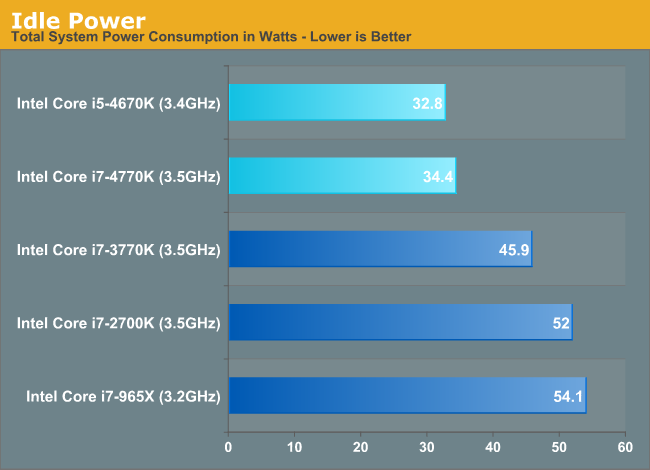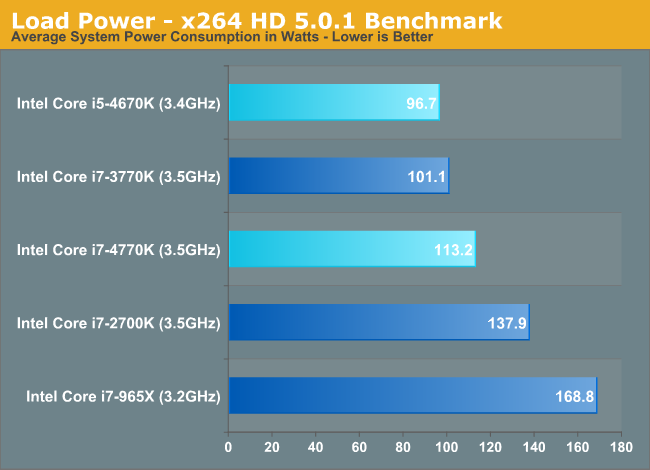The Haswell Review: Intel Core i7-4770K & i5-4670K Tested
by Anand Lal Shimpi on June 1, 2013 10:00 AM ESTPower Improvements
Although Haswell’s platform power is expected to drop considerably in mobile, particularly with Haswell U and Y SKUs (Ultrabooks and ultrathins/tablets), there are benefits to desktop Haswell parts as well.
There’s more fine grained power gating, lower chipset power and the CPU cores can transition between power states about 25% quicker than in Ivy Bridge - allowing the power control unit to be more aggressive in selecting lower power modes. We’ve also seen considerable improvements on lowering platform power consumption at the motherboard level as well. Using ASUS’ Z77 Deluxe and Z87 Deluxe motherboards for the Haswell, Ivy and Sandy Bridge CPUs, I measured significant improvements in idle power consumption:

These savings are beyond what I’d expect from Haswell alone. Intel isn’t the only one looking to make things as best as can be in the absence of any low hanging fruit. The motherboard makers are aggressively polishing their designs in order to grow their marketshare in a very difficult environment.
Under load, there’s no escaping the fact that Haswell can burn more power in pursuit of higher performance:

Here I’m showing an 11.8% increase in power consumption, and in this particular test the Core i7-4770K is 13% faster than the i7-3770K. Power consumption goes up, but so does performance per watt.
The other big part of the Haswell power story is what Intel is calling FIVR: Haswell’s Fully Integrated Voltage Regulator. Through a combination of on-die and on-package circuitry (mostly inductors on-package), Haswell assumes responsibility of distributing voltages to individual blocks and controllers (e.g. PCIe controller, memory controller, processor graphics, etc...). With FIVR, it’s easy to implement tons of voltage rails - which is why Intel doubled the number of internal voltage rails. With more independent voltage rails, there’s more fine grained control over the power delivered to various blocks of Haswell.
Thanks to a relatively high input voltage (on the order of 1.8V), it’s possible to generate quite a bit of current on-package and efficiently distribute power to all areas of the chip. Voltage ramps are 5 - 10x quicker with FIVR than with a traditional on-board voltage regulator implementation.
In order to ensure broad compatibility with memory types, there’s a second input voltage for DRAM as well.
FIVR also comes with a reduction in board area and component cost. I don’t suppose this is going to be a huge deal for desktops (admittedly the space and cost savings are basically non-existent), but it’ll mean a lot for mobile.
No S0ix for Desktop
You’ll notice that I didn’t mention any of the aggressive platform power optimizations in my sections on Haswell power management, that’s because they pretty much don’t apply here. The new active idle (S0ix) states are not supported by any of the desktop SKUs. It’s only the forthcoming Y and U series parts that support S0ix.










210 Comments
View All Comments
Khato - Sunday, June 2, 2013 - link
Based on the published Haswell 4C GT2 die shot I believe that your estimates for the graphics area are quite high. It's relatively simple to derive the graphics area on 4C GT2 now that we know the total die size - should be somewhere in the vicinity of 58mm^2. Double that and you get 116mm^2 for GT3.As for the remaining 29mm^2 delta between 4C GT2 and 4C GT3 die sizes... I'd chalk that up to both inefficiencies due to going with a more square die instead of the long and skinny that's been with us since SNB and the extra logic/IOs necessary for the eDRAM L4.
Regardless, there's no question that the 174mm^2 figure for GT3 is incorrect as the 4 cores, associated L3, and system agent on the 4C GT2 die take up approximately 119mm^2, and adding 174mm^2 to that would yield a 293mm^2 die size.
Bobsama - Sunday, June 2, 2013 - link
I too am on a Core i7-950. I bought it in April 2012. If this system died and I was building anew, I'd probably do it--I'd probably grab an i7-4770K. But for $500, notta chance!LeetMiniWheat - Sunday, June 2, 2013 - link
Would have been nice to see some actual CPU-bound games, like Skyrim. Or something low res to take the load completely off the GPU.roltzje - Sunday, June 2, 2013 - link
It doesn't take a genius to figure whats going on here. Competition spurs innovation. There is no competition for mid-high end desktop processors, or even laptop processors really. AMD only keeps up with mid range because they have to set very high clocks on their inferior architecture.Where the competition is is in mobile. Smartphones and tablets. By moving Haswell down this generation, Intel is getting themselves closer to be a true competitor in that space. This year we should see a power and battery life combination that ARM cannot reach.
There are also huge gains for gaming and gaming laptops. A 14-15" mid-ranger cost $500 with Iris graphics should be able to run most games decently now without all-minimum settings. Especially given that the PS4 and XBO are running x86 low to mid range graphics, I can easily see Haswell notebooks keeping up, especially Iris pro laptops, which I would assume can come in under $1000 and in relatively slim form factors.
deepblue08 - Sunday, June 2, 2013 - link
I think they should benchmarks this new CPU with 2-3GPUs. I don't think 1 video card is enough to really test the strength of new cpus, which is why the difference between ivy bridge and haswell is so small. Give them 2-3 GPUs to work with and see if they can really step-up.Yahma - Sunday, June 2, 2013 - link
YAWN... with no competition from AMD, Haswell offers none to just a few % improvement over the previous generation (depending on who's benchmarks you believe), higher power consumption, and fewer features (ie. no virtualization extensions on the higher end models) all at a higher price that requires one to purchase a new motherboard.... No Thanks!just4U - Sunday, June 2, 2013 - link
That was covered in a previous article.. it was established that the 3770K was the go to cpu for multiple video card systems. (altho.. I'd say this would do in a pinch as would the previous 2600/2700K)Yahma - Sunday, June 2, 2013 - link
YAWN... with no competition from AMD, Haswell offers none to just a few % improvement over the previous generation (depending on who's benchmarks you believe), higher power consumption, and fewer features (ie. no virtualization extensions on the higher end models) all at a higher price that requires one to purchase a new motherboard.... No Thanks!mcbowler - Sunday, June 2, 2013 - link
thanks for posting "CPU Performance: Going Even Further Back" almost twice as fast as my i5 750. I just might upgrade when the NCASE M1 is available.araczynski - Sunday, June 2, 2013 - link
either way, should be a serious boost in power to my aging E8500 :)